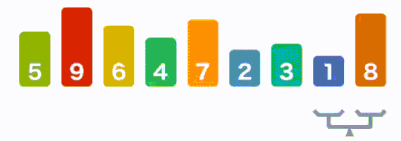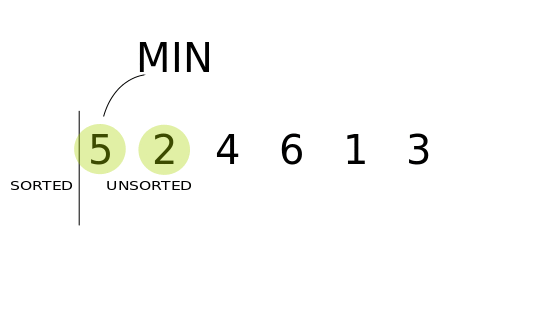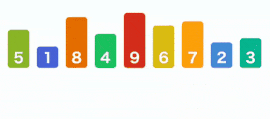Sorting
- To sort an array in an order

Types of sorting

Complexity of types of sorting
Bubble Sort 버블 정렬
- Swaps two consecutive elements to order until no more swaps occur
- Has a time complexity of O(N^2)


def bubble_sort(array):
n = len(array)
ans = []
for i in range(n-1):
# For i = 0 and n = 5, n-i-1 = 4
# Last element does not need to be evaluated,
# then the second to last element, and so on
for j in range(n-i-1):
# Evaluate the current element and the next element
if array [j] > array[j+1]:
# If the next element is smaller, then swap
array[j], array[j+1] = array[j+1], array[j]
return array
Selection Sort 선택 정렬
- Selects the smallest element in the array, then places it to the first index
- Repeat with the rest of the elements
- Has a time complexity of O(N^2)


def selection_sort(array):
n = len(array)
for i in range(n-1):
minIndex = i
# The ith (1st, 2nd, etc.) element
# does not need to be evaluated
# after switching elements
for j in range(n-i):
# If i = 0 and j = 1, evaluate if array[1] is smaller than [0]
# If i = 0 and j = 2, evaluate if array[2] is smaller than [0]
# So i+j evaluates all values after ith element
if array[i+j] < array[minIndex]:
# Swap values if array[i+j] is smaller than array[i]
# Swap occurs once, so this determines the index of the smallest value
# then swap outside the for j loop
minIndex = i+j
array[i], array[minIndex] = array[minIndex], array[i]
return arrayInsertion Sort 삽입 정렬
- Compares the current element with the next element.
- If the next element is smaller, then all the elements to the left are compared.
- The smaller element swaps places one by one with larger elements to the left.
- Has a time complexity of O(N^2)

def insertion_sort(array):
n = len(array)
# The first element does not need to be evaluated
for i in range(1, n):
# Loops through all elements to the
# left of the element i
for j in range(i):
# If i = 2, then j is 0 or 1
# i-j = 2 or 1 and i-j-1 = 1 or 0
# This is because the current element must
# compare each element to the left and swap one by one
if array[i-j] < array[i-j-1]:
array[i-j], array[i-j-1] = array[i-j-1], array[i-j]
# If the current element is bigger, break
# and evaluate the next element to the right
else:
break
return arrayMerge 병합
Merge and sort two sorted arrays.
- Has a time complexity of O(N), since array1 and array2 create an array of length N
- Create two variables that track the index of the arrays
- If arrayA[0] is smaller than arrayB[0], then append arrayA[0] to arrayAns and increase arrayAIndex by 1
- The next loop would compare arrayA[1] to arrayB[0] and so on
- If there is a leftover element in arrayA or arrayB, append the last element to arrayAns
def merge(array1, array2):
array = []
array1Index = 0
array2Index = 0
while array1Index < len(array1) and array2Index < len(array2):
if array1[array1Index] < array2[array2Index]:
array.append(array1[array1Index])
array1Index += 1
else:
array.append(array2[array2Index])
array2Index += 1
# If there is a leftover element in array 2
if array1Index == len(array1):
while array2Index < len(array2):
array.append(array2[array2Index])
array2Index += 1
# If there is a leftover element in array 1
if array2Index == len(array2):
while array1Index < len(array1):
array.append(array1[array1Index])
array1Index += 1
return arrayMerge Sort 병합 정렬
Uses the concept from the merge function above to sort an array.
Merge Sort uses the concept called Divide and Conquer (분할 정복).
- Splits the array into N/2^k times, where k is the number of times needed to divide the array into single arrays.
- N/2^k = 1, therefore k = log2N. Each kth process has a time complexity of O(N) (due to the merge function above)
- This gives the time complexity of log2N O(N), or **O(N logN)**
- Separates the array into halves until the elements are coupled
- The two couples are sorted, then merged with another couple
- The merged group is sorted, then so on until the entire array is merged again
For an array of length N, MergeSort(0,N) should run Merge(MergeSort(0, N/2) + MergeSort(N/2,N)).
This behavior is recursive.

def merge_sort(array):
# 탈출 조건
# A single array is already "sorted"
if len(array) <= 1:
return array
# Get the middle index of the array
mid = len(array) //2
# Recursively run merge_sort
leftArray = merge_sort(array[:mid])
rightArray = merge_sort(array[mid:])
return merge(leftArray, rightArray)